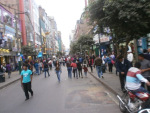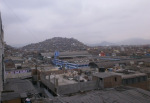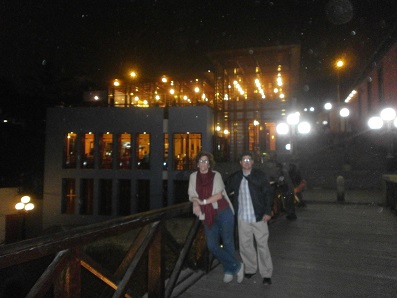When someone asks me what I thought of Lima, I amswer that I was not in Lima but in Miraflores, an area of the city located along the seacoast where the green spaces are impeccable, and the traffic-filled streets are clean and crowded with the Toyotas and Kias. Even the dogs and cats are looked after by the local government. There are tall buildings, enormous stores and restaurants. That’s Miraflores, a district of Lima where anyone would enjoying living, even in spite of high walls and electrical fences.
I was invited by the Institute for Freedom to participate in a seminar on digital journalism and communication technology. These were luxurious conferences, attended by people highly-qualified in their fields. I went to learn and I learned a lot. I also had the opportunity to meet some wonderful people. It felt strange to be treated so cordially in the markets, restaurants, stores and when asking for directions on the street.
 One sees a different Lima in Gamarra, an impressive commercial perimeter whose counterpart — if there is one — might only be found in some Asian megalopolis. In Gamarra you can hear money growing. This pedestrian-oriented rectangle produces more wealth than many countries. All the activity can make you feel dizzy. Not far from here I can see a hill encrusted with little houses, which arouses my curiosity. It is a poor area where the police do not dare enter, where the recipe for material success goes unfulfilled. We have to leave Gamarra before nightfall.
One sees a different Lima in Gamarra, an impressive commercial perimeter whose counterpart — if there is one — might only be found in some Asian megalopolis. In Gamarra you can hear money growing. This pedestrian-oriented rectangle produces more wealth than many countries. All the activity can make you feel dizzy. Not far from here I can see a hill encrusted with little houses, which arouses my curiosity. It is a poor area where the police do not dare enter, where the recipe for material success goes unfulfilled. We have to leave Gamarra before nightfall.
I would have liked to check out the bar frequented by Zavalita and Ambrosio in Conversation in the Cathedral, or to walk through the University of San Marcos and see if there is a bust, at least a plaque, commemorating Vallejo’s time there.* I had to settle for a bridge and the Chabuca Granda shopping mall in Barranco — a beautiful old area — and a delicious ride on a double-decker tour bus to the city center.
We Cubans always end up talking about food, but to go to Peru and not talk about its food would be a crime. The seviche — which is also spelled with a c and a b — in the food market is unforgettable, as are the huancaína fries and the enormous sweet corn kernels.
 I must admit that I never dreamt that in a such busy week I would make new friends who will forever stay with me. And there was the city itself, which I pretended to recognize even when Miraflores did not resemble the opulent and modern residential area of Vargas Llosa’s novels.
I must admit that I never dreamt that in a such busy week I would make new friends who will forever stay with me. And there was the city itself, which I pretended to recognize even when Miraflores did not resemble the opulent and modern residential area of Vargas Llosa’s novels.
Translator’s note: A reference to a novel, Conversation in the Cathedral, by Peruvian author Mario Vargas Llosa. The plot revolves around the lives of Santiago Zavala and Ambrosio — one the son of a government minister, the other his chauffeur. A chance meeting leads to a conversation between the two at a bar known as the Cathedral. Zavala is a student activist at the National University of San Marcos who opposes the Peruvian dictatorship of the 1950s.
13 June 2014

